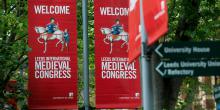CONFERENCE: Cartusiana-sponsored double-session at Leeds IMC 2020

Carthusians Over the Borderline
Monday 6 July 2020
Organisers: Stephen J. Molvarec, School of Theology & Ministry, Boston College & Tom Gaens, Ruusbroecgenootschap, Universiteit Antwerpen
Session I: Deserts, Limits, Enclosure
Monday 6 July 2020: 14.15-15.45
Moderator/Chair:
Kathryn Jasper, Department of History, Illinois State University
For the canonization of Hugh of Lincoln, the papal register mentioned that the 'Carthusian order surpasses all other orders in terms of posing limits to desire.' For sure, Carthusians were famous for creating both material (e.g., 'desertum' and 'terminus') and spiritual borders. These shaped a unique monasticism - in terms of how Carthusians thought about their lives, and their relationships with the world and the divine. This session discusses the institutional-juridical and practical development of the Carthusian enclosure, its negotiation of solitary, communal, and external spaces, as well as its influence on later medieval religious groups.
- Paper 238-a: 'On a Horse with No Name': Limits, Boundaries, Possessions, and the Medieval Carthusian Concept of 'Desert'
Stephen J. Molvarec, School of Theology & Ministry, Boston College - Paper 238-b: The Cell Alone Will Not Teach You Everything: Crossing Inner and Outer Boundaries in Carthusian Life
Demetrio S. Yocum, Center for Italian Studies / Devers Family Program in Dante Studies, University of Notre Dame - Paper 238-c: 'Unheard and unseen': Carthusian Inclusio in the Modern Devotion
Tom Gaens, Ruusbroecgenootschap, Universiteit Antwerpen
Session II: Life, Death, Imagination
Monday 6 July 2020: 16.30-18.00
Moderator/Chair:
Emilia Jamroziak, Max-Weber-Kolleg für kultur- und sozialwissenschaftliche Studien, Universität Erfurt / Institute for Medieval Studies, University of Leeds
The Carthusians, just as other monks, lived in between the borders of their symbolic death to the world ('entrance' and 'ordination'), and their biological death ('obit'), the space of both the monstrous and the sublime. Although the lives of medieval Carthusians were often invisible, available images were increasingly projections of exemplary reputations for strictness and holiness. There is a paradoxical relationship to be found in the desire to remain within their enclosures and the reputation they enjoyed. This session examines the lives, deaths, and images of medieval Carthusians, and how these brought them into relationship with the medieval society.
- Paper 338-a: Defining the Boundaries of Carthusian Holiness: The History of the Carthusian Order in the Middle English Universal Chronicle in Oxford, Bodleian Library, MS e Museo 160
Kaan Vural Gorman, Institute for Medieval Studies, University of Leeds - Paper 338-b: The Image of the Carthusian in Jean de Berry’s Prayerbooks
Julian Luxford, School of Art History, University of St Andrews - Paper 338-c: From Ordination to Obit: The Prosopography of English Carthusians, c. 1350-1540
David E. Thornton, History Department, Bilkent University, Turkey
